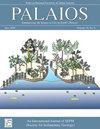RAEDERICHNUS DONDASI A NEW TRACE FOSSIL FROM THE EARLY PALEOZOIC OF ARGENTINA REVEALS SHOALING BEHAVIOR IN EARLY FISH
IF 1.5
4区 地球科学
Q2 GEOLOGY
引用次数: 0
Abstract
Abstract: Although vertebrate carcasses––particularly those assigned to fishes––are abundant in the fossil record, the literature rarely mentions fishes as trace producers. Herein we present evidence that was possibly overlooked in previous studies. Study of more than 100 large, shallow, teardrop-shaped, imprints that are aligned, with few overlapping each other, from early Paleozoic (probably Silurian based on trace fossils) outcrops in western Gondwana (southeastern Argentina), are identified as the oldest example of shoaling behavior. To understand the nature of the behavior, we considered analog (vertebrate and invertebrate) extant and extinct taxa. We compare and discuss the superficial similarities with certain traces, in particular Selenichnites isp. and erect a new ichnotaxon, Raederichnus dondasi isp. nov. for the Argentinian material. We report for the first time from the Balcarce Formation Psammichnites isp., in association with Herradurichnus scagliai, both forming minor components of the ichnoassemblage. Raederichnus dondasi and the accompanying traces are preserved in three-dimensional dunes, developed in a tide-dominated shallow marine environment. Given the morphological resemblance, and paleoecological context, we consider that Raederichnus dondasi might have been produced by fish while “resting”. Finally, this aggregation of trace fossils suggests shoaling related to feeding or breeding on the shallow marine bottom surface.阿根廷早古生代的一个新的痕迹化石RAEDERICHNUS DONDASI揭示了早期鱼类的浅水行为
摘要:尽管脊椎动物的尸体——尤其是鱼类的尸体——在化石记录中大量存在,但文献中很少提到鱼类是微量物质的制造者。在此,我们提出的证据可能在以前的研究中被忽视。对贡瓦纳西部(阿根廷东南部)早古生代(根据化石痕迹,可能是志留纪)露头的100多个大的、浅的、泪滴状的、排列整齐、很少重叠的印记的研究,被认为是最古老的浅滩行为的例子。为了理解这种行为的本质,我们考虑了现存和灭绝的类群(脊椎动物和无脊椎动物)。我们比较并讨论了表面上与某些痕迹的相似性,特别是与亚硒酸盐的相似性。并建立了一个新的鱼分类单元——黄龙(Raederichnus dondasi)。11月阿根廷材料。我们首次报道了Balcarce组Psammichnites isp。,与Herradurichnus scagliai一起,都构成了鱼群的次要组成部分。在潮汐主导的浅海环境中发育的三维沙丘中保存着东达沙鼠及其伴生痕迹。考虑到形态上的相似性和古生态背景,我们认为唐氏Raederichnus dondasi可能是由鱼类在“休息”时产生的。最后,这些化石的聚集表明浅海底部表面与觅食或繁殖有关。
本文章由计算机程序翻译,如有差异,请以英文原文为准。
求助全文
约1分钟内获得全文
求助全文
来源期刊

Palaios
地学-地质学
CiteScore
2.80
自引率
12.50%
发文量
40
审稿时长
6 months
期刊介绍:
PALAIOS is a monthly journal, founded in 1986, dedicated to emphasizing the impact of life on Earth''s history as recorded in the paleontological and sedimentological records. PALAIOS disseminates information to an international spectrum of geologists and biologists interested in a broad range of topics, including, but not limited to, biogeochemistry, ichnology, paleoclimatology, paleoecology, paleoceanography, sedimentology, stratigraphy, geomicrobiology, paleobiogeochemistry, and astrobiology.
PALAIOS publishes original papers that emphasize using paleontology to answer important geological and biological questions that further our understanding of Earth history. Accordingly, manuscripts whose subject matter and conclusions have broader geologic implications are much more likely to be selected for publication. Given that the purpose of PALAIOS is to generate enthusiasm for paleontology among a broad spectrum of readers, the editors request the following: titles that generate immediate interest; abstracts that emphasize important conclusions; illustrations of professional caliber used in place of words; and lively, yet scholarly, text.
 求助内容:
求助内容: 应助结果提醒方式:
应助结果提醒方式:


